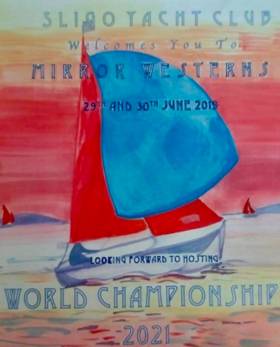Displaying items by tag: Mirror dinghy
Next up on the Irish Mirror dinghy calendar is the Western Championships to be held against the backdrop of Rosses Point in County Sligo.
A good turnout is expected under Aisling Gillen, Sligo Yacht Club Commodore and her team adding to the weekend's racing programme.
This event will be of special interest to those intending to compete at the Mirror World Championships in 2021 to get a sense of local tidal and sailing conditions.
#mirror – The 2014 Mirror dinghy Eastern Championships were completed on Sunday in superb racing conditions at Sutton Dinghy Club with victory for local pairing Robert Dickson and Meisha Johnston.
With Junior and Leaving Cert exams coming shortly a smaller than expected fleet of 11 Mirrors arrived in Sutton for the second regional event of the season. While the field was small it included rising Sutton talent Shane McLoughlin and Conor Twohig, current National Champion Cian Hickey from Skerries as well as top Irish Mirror sailors Tiernan Dickson (L Ree) and Jack Maye (Sligo). With local sailor Sinead Dickson preparing for exams, brother Robert teamed up with her young crew Meisha Johnston.
The fleet launched in gusty 15-20kts conditions late Saturday morning and PRO Richard Kissane got 3 great races completed in the Dublin Bay in windy and lumpy conditions.
In Race 1, Mcloughlin/Langan took a very close race from Hickey/Hickey with T.Dickson/Leech in 3rd. Race 2 saw R.Dickson/Johnston get into their stride and eventually take the gun in a close finish from Club mate McLoughlin/Langan with Sligo's Maye/White in 3rd.
In the final race of the day locals Twohig/Gibney had a super start and led for 3 legs holding off R.Dickson/Johnston and Hickey/Hickey. A broken main-sheet block on the second last leg allowed Dickson/Johnston the chance to ease themselves in front. Twohig/Gibney did ever so well to hold off the Hickey brothers from Skerries and take a superb 2nd.
On Sunday with a later tide and 15kts mainly from the South, PRO Richard Kissane had to shift the courses a number of times over the day as the wind shifted left and right throughout the afternoon.
With the gybe mark right in under Red Rock, Howth the fleet had an ongoing audience up close on the cliff walk throughout the afternoon. With 4 boats within 3 points at the start of the day and only a quarter of a point between Dickson/Johnston in 1st and McLoughlin/Langan 2nd the first race was always going to be a marker for the rest of the day.
In Race 4, Mcloughlin/Langan got a super start and developed a substantial lead. But Robert Dickson, the recently crowned 420 National Champion was never going to let the lead boat have it all there own way. Leg after leg Dickson/Johnston gradually worked there way back up till they were no more than a boat length behind at the final leeward mark. On the line Mcloughlin/Langan held off the challenge only to discover they had been OCS. Despite the disappointment, this was a superb race from McLoughlin/Langan pairing. The minor places went to Maye/White (Sligo YC) and Hickey/Hickey (SkerriesSC).
Race 5 continued where the earlier races had left off with McLoughlin/Langan never far from Dickson/Johnston. These 2 boats kept ahead of a tight tussle between Sligos Jack Maye and Skerries Cian Hickey. In the end the Dickson/Johnston team put some distance between themselves and fellow Club mates McLoughlin/Langan to take a second victory on the day. Jack Maye took 3rd and fast finishing and former event winner Tiarnan Dickson from Lough Ree took 4th from Cian Hickey.
With 4 race wins from 5, any finish bar a disqualification in the 6th and last race and Dickson/Johnston would be assured of victory. The chase for runner up spot was still very much on between former event winner Cian Hickey and Shane McLoughlin from the host Club. The final race of the day saw the top 5 or 6 boats battle it out in by now a very steady 15kts. By the gybe mark it was Dickson/Johnston who held the lead closely followed by McLoughlin/Langan. The chasing pack could make no inroads into the leading pair on the concluding legs which meant victory for Robert Dickson and his young crew Meisha Johnston. Shane McLoughlin and his crew Oscar Langan held off the fast chasing National Champion Cian Hickey to take a well deserved 2nd place in this the second regional event of the season.
The leading Silver fleet boat in the series in only their second event were Samuel & Imogen Wray from Sligo YC. The next event is the Mirror Northern Championship in Royal North of Ireland YC, Cultra on June 21st.
Place Helm/Crew Club
1 R.Dickson/M.JohnstonSDC
2 S.McLoughlin/O.LanganSDC
3 C.Hickey/E.HickeySSC
4 J.Maye/M.WhiteSYC
5 T.Dickson/A.LeechLRYC
6 C.Twohig/J.GibneySDC
7 S.Wray/I.WraySYC
8 C.Croasdel/O.McAllisterLRYC
9 R.McAllister/L.CroasdelSchull Harbour
10 S.Kelly/A.HarperSDC
11 S.Nicholson/M.MartinSYC
American Sailing's Great Survivor
#offshoresailing – There were four of them, back in 1968 in New York. There was Dick Nye (1903-1988). Briefly a theatrical hopeful, he'd got no further than spear carrier in an opera. But Broadway's loss was Wall Street's gain – the ebullient Nye had a stellar career in the wheelings and dealings of mergers and acquisitions and takeover battles, and this funded a love of offshore racing which he hadn't discovered until he was 44 .
Also present was his son Richard B Nye, business colleague and longtime shipmate in a hugely successful shared offshore racing career on both sides of the Atlantic, and across it. "Richard was the detail guy. Richard could remember every tack and sail combination on every race they had ever sailed. I only exaggerate a little. Between the two of them, they got maximum performance out of boat and crew."
The speaker is Sheila McCurdy, Commodore of the Cruising Club of America 2011-2012. She knew the Nyes well and sailed with them too, as she is the daughter of the third man present, yacht designer Jim McCurdy (1922-1994). Having served his time with the great Philip Rhodes, rising to head the Rhodes office's sailboat division, he had now set up his own partnership with his former boss's son Body Rhodes, and a new 48ft offshore racer for Dick and Richard Nye was one of McCurdy & Rhodes' first commissions.
McCurdy worked harmoniously with the Nyes. In 1955 in the Rhodes office, he had overseen the creation of their previous boat, the 54ft yawl Carina II, which had won both the 1955 and the 1957 Fastnets overall, and her class in the Bermuda Race too, plus a couple of Transatlantics. Carina II had been and still was a great boat, but the CCA rule had moved on. Being a beamy centreboard yawl had been a rating disadvantage under the RORC Rule, which made Carina II's Fastnet double all the more remarkable. But by 1968 it no longer conferred any advantage under the American rule either, something which was expected to be emphasised with the new International Offshore Rule.
It was hoped this ground-breaking global measurement rule would be unveiled by 1970. However, the Nyes - once they'd decided to move - were men in a hurry, and in August 1968 with Jim McCurdy they finalized a design which they reckoned would be a useful template for those framing the IOR. It was that and more.
The boat which emerged from their deliberations became the fourth member of the quartet, a personality in her own right. And with the death of Richard B Nye on March 14th at the age of 81, only Carina is left - American sailing's great survivor. She is still winning major offshore races in her fifth decade, still giving enormous pleasure to all who sail on her, and comfortably belying her age of 44 with timeless good looks.
She was built in aluminium, and kept as simple as possible. How about teak laid decks, even with their inevitable weight? As they say on Wall Street – fuggedaboudit. It wasn't that the Nyes were tight with the money, though they did shop around for value – their previous Carina had been built in Germany in a yard near Hamburg, as that offered the best deal at the time. But they readily spent money on the boat, particularly on the sails and rig, when genuine benefit would result.
And Jim McCurdy had an interesting approach to expenditure in building one-off yachts. Despite being of Ulster-Scots descent – you'll find McCurdys on Rathlin Island, and they're big around Ballymena and in The Glens – Jim McCurdy had a refreshingly open attitude to budgets, at variance with the popular perception of the Ulster-Scots' reputation for parsimony. In response to questions from Arthur Beiser for the latter's authorative book The Proper Yacht (Second Edition 1978), McCurdy suggested that anyone thinking of building the dreamship should consider "throwing financial responsibility to the winds and grabbing your dream as it slips away into an even more unfriendly future. There are those who have acted in this fashion and their irresponsibility turned, in fact, into wisdom that produced a great reward in enjoyment of sailing".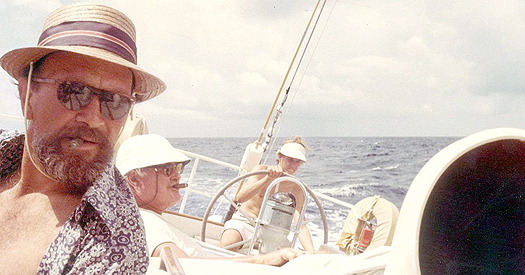
Jim McCurdy and Dick Nye aboard Carina in the 1972 Transatlantic Race to Spain, which they won by a huge margin. They were both great men for their cigars, earned here after a tactical gamble had paid off in spades.
Another time, he commented that those who concentrated on saving the pennies at every stage ended up spending more and achieving less than those who took the broader more generous view. Certainly with the previous Carina, when the Nyes' Wall Street speciality financial services firm was a much more modest operation than had become by 1968, the yacht style finish was to the highest standard, with all the trimmings. But with the sparse new boat, all was in line with the purpose of providing performance with just the basics of comfort needed by dedicated amateur crews for long races, and this remarkably handsome yet decidedly non-yachty sloop made her international debut at Cork in July 1969.
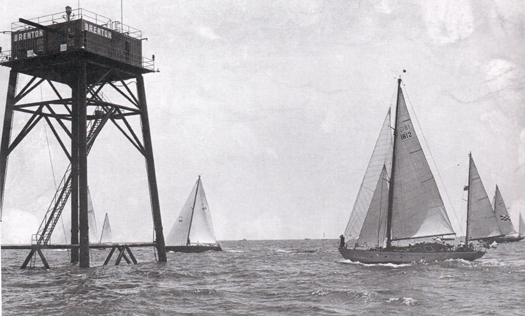
Shortly after the start of the 1969 Transatlantic Race to Cork, with Huey Long's maxi Ondine and the new Carina leading the only Irish entry, Perry Greer's Helen of Howth, past the Brenton Reef Light Tower. Photo: Tom Matthews
She'd raced Transatlantic, against a fleet which included one Irish entry, Perry Greer's John B Kearney-designed 54ft centreboard yawl Helen of Howth, which ironically had in some ways been inspired by the previous Carina. But Helen's owner was an inveterate gadgeteer and liked his cruising comforts. Even in racing trim, the Irish boat was no more than a fast cruiser, floating well below her designed waterline. The new austere Carina by contrast was very much a contender. So although in a big boat race to Cork the winner was the souped-up 12 Metre American Eagle from the 66ft S&S yawl Kialoa – Ted Turner from Jim Kilroy: there were giants in ocean racing in those days – Carina won her class in style, and her crew were enthused about her easy speed and good handling characteristics. Even today, after hundreds of thousands of miles, it's said she has never broached.
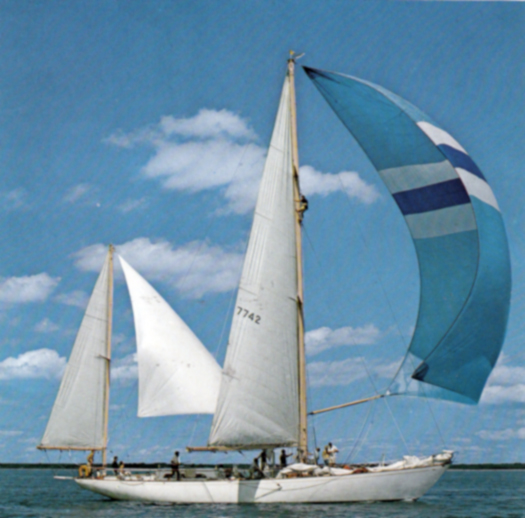
Jim Kilroy's 66ft yawl Kialoa II placed second in the 1969 Transatlantic Race to Cork.
That Cork visit resulted in Transatlantic links to the Nyes which two years later in 1971 had the 22-year-old Ron Cudmore sail as crew on Carina in a fast delivery passage across the Atlantic. Dick Nye wanted to get to the 1971 Admirals Cup, Ron wanted to get home from the US, and as no Transatlantic Race was scheduled, they could sail the northern Great Circle route with no mandatory waypoint to keep them clear of ice. Carina zapped across in just over a fortnight on the open ocean - "Fast and very cold," as Ron recalls. "great boat, awesome skipper".
Another Irish sailor who particularly remembers her arriving in Crosshaven back in 1969 is Neil Kenefick. Aged 11 at the time, he and his father were invited to sail on Carina from Cork to Kinsale as the Nyes fitted in a tiny bit of cruising before heading off for Dick Nye's favourite regatta, Cowes Week, which included the Admirals Cup in which Carina was a member of the winning American Team.
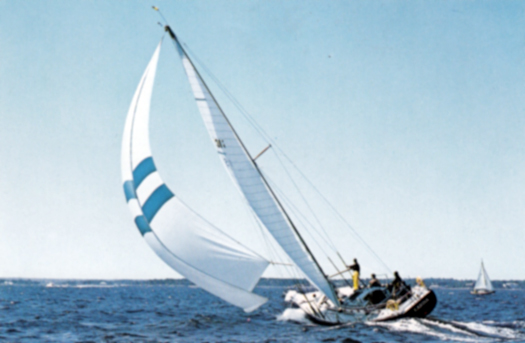
Carina on the Solent in 1969, when she was a member of the winning American Admiral's Cup team. It's said that she has never broached, and here – tight spinnaker reaching under her original configuration of smaller rudder with trim tab on keel – she is giving the helmsman no problems.
Neil met up with them again in Cowes ten years later, when he himself was on the then-leading Irish Admirals Cup team aboard Golden Apple, and the Nyes were properly impressed. But Golden Apple was a 1979 Fastnet casualty, along with Ireland's Admirals Cup hopes, whereas Carina went round in style with three generations of Nyes aboard – Richard B's son Jonathan was in the crew. At the height of the gale Dick Nye, aged 76, roped himself into the cockpit the better to savour this storm of storms: "This is GREAT" he bellowed, "truly utterly GREAT!"
The boat had already won a Bermuda Race overall, and in 1982 with the old man finally feeling his years and retired from offshore racing, Richard Nye sailed as skipper on his own and Carina won the Bermuda Race overall again. The successes continued, but by the mid '90s the junior Nye was looking back on fifty years of active offshore racing. So Carina found an excellent new home with Rives Potts, whose CV included crewing for Dennis Conner in 12 Metres, and very varied boatyard work – it was he who had done most of the work in the angle-grinder event in Bob Derecktor's famous yard when Carina was given an up-dated keel and rudder profile to Scott Kauffmann designs in 1978.
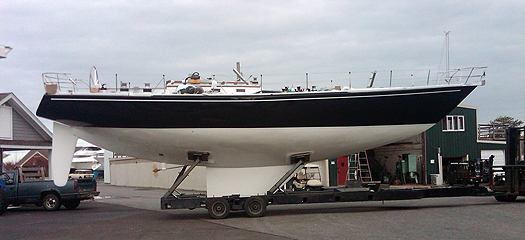
Carina's hull profile as it is today, with the new keel-rudder configuration to Scott Kauffmann designs fitted in 1978. Originally she's had a skeg-hung rudder with a trim tab on the keel. Photo: Rives Potts
Since then in Potts ownership, the only significant change has been a new mast in carbon. It has been noted that it lessens pitching. But other than that, this is still the same Carina, immaculately and lovingly maintained. In 2010 she won the Bermuda Race overall, then in 2011 she came cross the Atlantic and won Class 5 and placed fifth overall in the record fleet in the Rolex Fastnet Race. Then she simply sailed straight off to Sydney under the command of the next generation, and got sixth in class in the Hobart Race and won the informal "father-son" division, and then sailed on round the world with a particularly impressive east-west crossing of the Indian Ocean from Perth to Cape Town to get back to the US just in time for the Bermuda Race 2012, and she won overall in that yet again.
She won't be in the Fastnet this year, but it's likely she'll be back in 2015. Rives Potts is a flag officer of the New York YC, which will sending a fleet across for the Bicentennial of the Royal Yacht Squadron. And in that fleet, the boat for true sailors will be this modest 46-year-old black sloop, American sailing's great survivor, a global superstar.
THE HIPPY HAPPY MIRROR DINGHY
Did you know there used to be Mirror dinghies for hippies, driven by flower power? Believe me, there were – we bought one for family use back in 1977 from a former suburban hippy round Dun Laoghaire way. Instead of a simple paint job for the hull, she was decorated in flowers from end to end.
The guy we bought her from was Norman Long. These day, he is of course F. Norman Long, senior sailor emeritus, pillar of the yachting establishment, and basking in the deserved glow of having played a key role – along with Theo and Avril Harris - of getting the annual frostbite series inaugurated under the auspices of the Dun Laoghaire Motor Yacht Club, way back in 1974 or even earlier.
But in his more relaxed moments yonks ago, Norman would have dreamt of making the scene in San Francisco. I don't think he got there, yet he grew his hair long, and he painted his boat with psychedelic flowers on a pink background. But regrettably, it wasn't that which drew us to the boat. We simply wanted a Mirror dinghy because it offered so much for an impecunious family with two small children and another on the way, and Norman's was for sale as he was getting involved with offshore racing.
The Mirror was the right choice for us. They're great little big-hearted boats, one of the cleverest dinghy design concepts of all time. She gave us two happy summers and was everything we needed for local mini-cruises – some boats twice the size couldn't carry as many people - and the very occasional race. But it wasn't until the flowers had gone that we made our debut with our new pride-and-joy. We smuggled her back home on the roof of our battered little car, and hid her in the garage - it hadn't become an office in those days. When she reappeared, immaculate yacht white with a neat dark green boot-top – a proper boot-top, not silly stripes – the neighbours thought it was a different boat entirely.

Mirror action at Rosses Point in Sligo. This year the class is celebrating its Golden Jubilee, and the Worlds are at Lough Derg in August.
Photo: Bryan Armstrong
These fond memories are evoked by the fact that this month marks the Golden Jubilee of the Mirror Class Assocation. It was actually 1962 when DIY guru Barry Bucknell and ace dinghy designer Jack Holt pooled their considerable talents to produce the smallest possible boat which could do just about everything, and they succeeded brilliantly. Of course they're now mainly known for their racing, but for simply sailing they're great too, and seaworthy with it – one intrepid Mirror sailor managed to get all the way from Shropshire in England across Europe to the Black Sea.
The essence of the design is that it was dictated by what could be done with marine ply by amateur builders. The stitch-and-glue technique conferred strength and shape, while the need for economy and internal space dictated the pram bow.
Inevitably over the years, racing demands have meant that people have lost sight of the original very basic concept. For instance, they now have bermudan rig, where originally they'd a sensible sliding gunter set-up with all the spars stowable within the hull when un-rigged, which was very user friendly.
Less user-friendly was the need to keep weight and price down, thus they were built with ultra-light inexpensive plywood, of marine standard but pushing it a bit. It couldn't be neglected at all. So in time there were attempts to build competitive boats in lower maintenance glassfibre, and when the Worlds were held in Ireland in 2001, the Australians turned up with plastic boats which did the business.
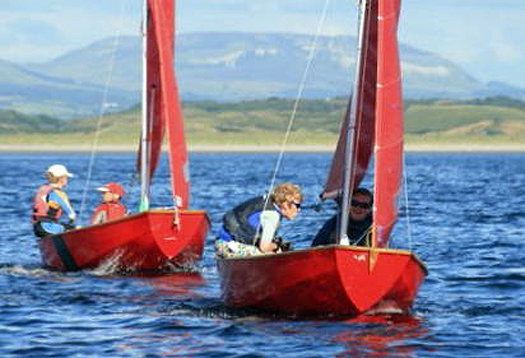
The shape of the Mirror dinghy is dictated by the demands of plywood construction, and the need for economy and light weight.
Photo: Bryan Armstrong
But in the long run, it's absurd to use fibreglass to build boats whose shape was created in the first place by the unique demands of plywood construction, utilising a totally hard chine shape. We mentioned that here some weeks ago in considering the 30ft van de Stadt-designed Royal Cape ODs. Those slippy little plywood sea sleds had given so much sport that somebody though it would be a great idea to build them in more durable glassfibre. But only four were built in plastic as the absurdity of sticking to the confines of a totally plywood design concept became obvious.
It should be possible to create a design which has the Mirror's excellent roominess, attractive sailing ability and compact size, while taking much greater advantage of the shape options which plastic construction offers. But of course, such a boat would need all the hassle of creating a new class, with its essential dedicated adherents. The Mirror dinghy comes with its own extraordinary ready-made hinterland of wonderful memories and great sport.
So we wish them a very happy 50th Birthday. And where does an impecunious sailing family go after two great years with a Mirror? Into a Squib of course – where else?
Mirror Euro Pics HERE!
Photographer Gareth Craig has loaded new images from the Mirror European dinghy championships in Sligo to the Afloat gallery. Click HERE.



























